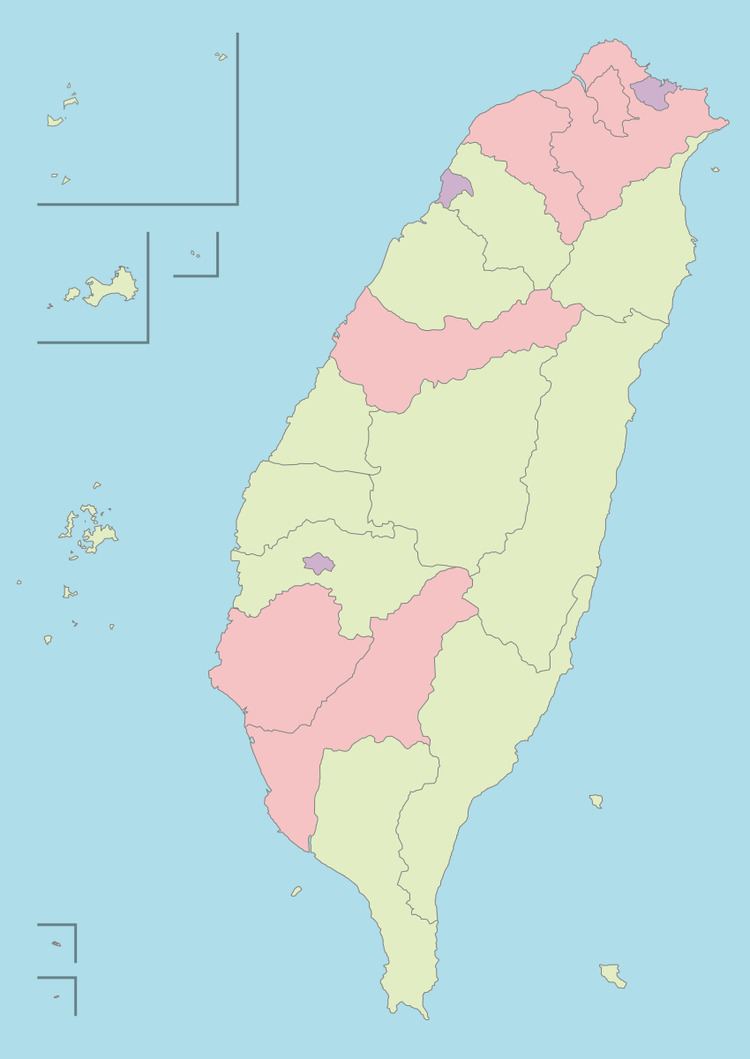Category Unitary State Number 13 | Location Taiwan | |
 | ||
Populations 12,506 (Lienchiang) – 1,291,474 (Changhua) Areas 11.4307 square miles (29.605 km) (Lienchiang) – 4,106.4360 square miles (10,635.620 km) (Hualien) Government County government, National Government | ||
A county (Chinese: 縣; pinyin: xiàn; Pe̍h-ōe-jī: koān) is an administrative division unit in Taiwan. Under the administrative structure of Taiwan, it is with the same level of a provincial city. Historically the counties were under the jurisdiction of provinces, but after the streamlining of provinces in 1998, they are all directly led by the central government.
Contents
History
The first administrative divisions named "county" (縣) was first established in 1661 by the Kingdom of Tungning. The later ruler Qing empire inherited this type of administrative divisions. With the increase of Han Chinese population in Taiwan, the number of counties also grew by time. By the end of Qing era, there were 11 counties in Taiwan.
Taiwan was ceded to Japan by the Treaty of Shimonoseki in 1895. The hierarchy of divisions also incorporated into the Japanese system in the period when Taiwan under Japanese rule. By the end of World War II in 1945, Taiwan was divided into eight (8) prefectures (州 and 廳). The prefectures were reformed into eight counties (縣) with the same name under Taiwan Province of the Republic of China. Their roman spellings were also changed to reflect the official language shift from Japanese to Mandarin Chinese, but characters remained the same. Note that most of the Japanese prefectural cities were reformed to provincial cities and are not a part of counties.
In late 1949, the government of the Republic of China lost the Chinese Civil War and was relocated to Taipei, Taiwan. In 1950, the counties in Taiwan were reorganized. Counties in populous western Taiwan were split into two to three counties. This pushed the number of counties up to 16. After the war, the government only controlled a few offshore islands of mainland China. These territories were reorganized into two counties: Kinmen and Lienchiang under Fukien. The number of counties under jurisdiction, 16 in Taiwan and 2 in Fukien, remained stable in the period of Martial law in Taiwan until early 1990s.
Following the democratic reforms in the early 1990s, more proposals of administrative division reforms were widely discussed and ultimately caused some populous counties be reformed to special municipalities in the 2010 and 2014. These counties are:
Currently, the counties are established according to the Local Government Act under the supervision of the Ministry of the Interior. This act also endorses some special articles that grants counties with a population of over two million can grant some extra privileges in local autonomy that was designed for special municipalities. This type of counties are often called quasi-municipalities (準直轄市). This term applied to New Taipei and Taoyuan before they became special municipalities.
Current Counties
There are currently 13 counties:
Under Article 9 of the Additional Articles of the Constitution of the Republic of China, regulated by the Local Government Act, each county has a government headed by an elected county magistrate and an elected county council exercising legislative functions. The governing bodies (executive and legislature) of the counties are:
